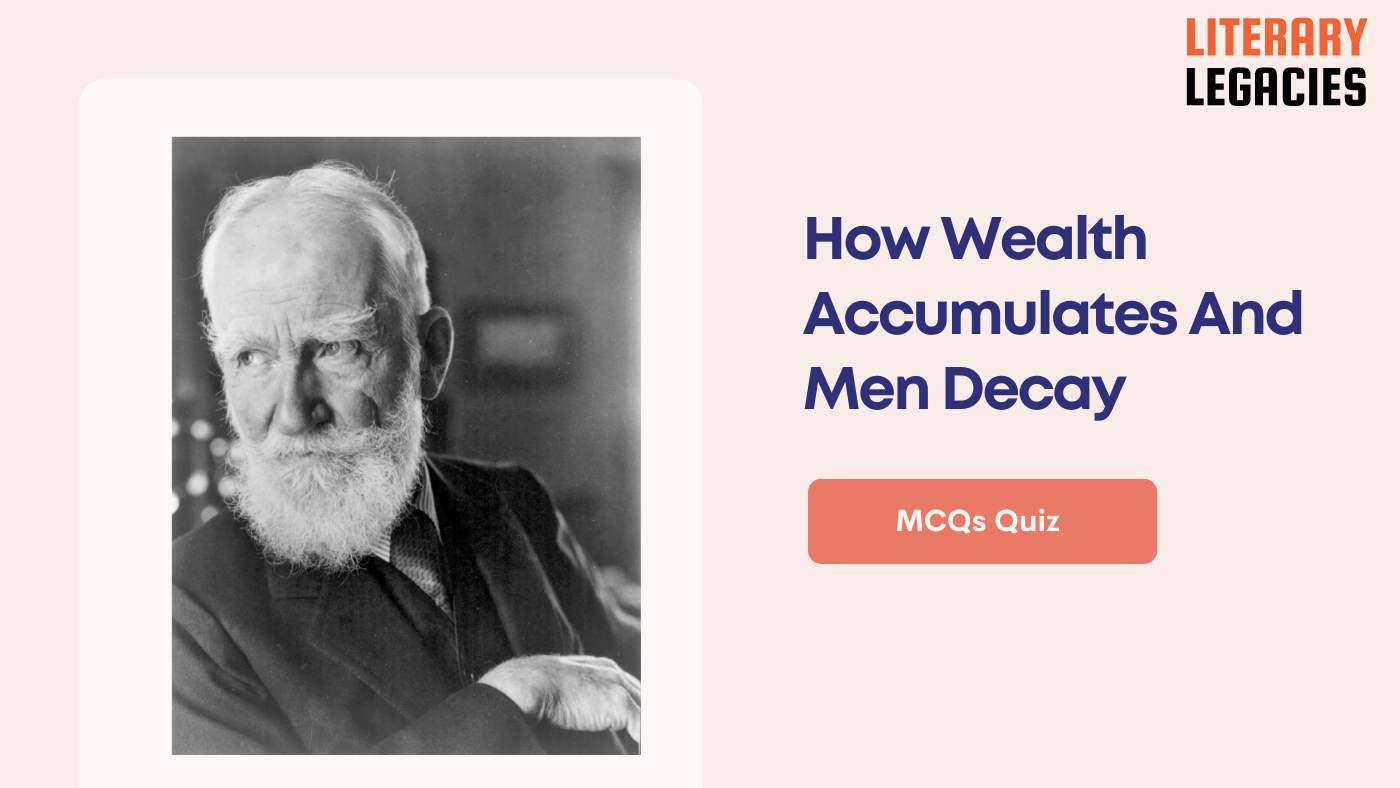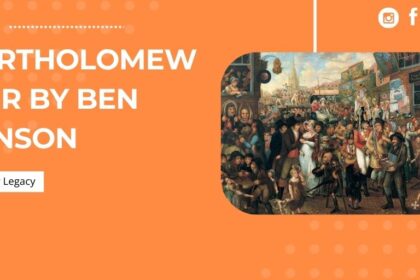1. What has led to a disastrous unmaking for humankind?
A. The spread of romantic nonsense in literature and media
B. The decline of the capitalist system
C. The replacement of human knowledge with machines
D. The rise of education and enlightenment
Answer: The replacement of human knowledge with machines (C)
The replacement of human skills with machines has led to a loss of knowledge and understanding.
2. What is the result of the capitalist system, according to Shaw?
A. A widespread understanding of how things are made
B. A universal ignorance of how things are made and done
C. A balanced mix of education and ignorance
D. A focus on traditional crafts and skills
Answer: A universal ignorance of how things are made and done (B)
The capitalist system has led to a lack of understanding about how products are made.
3. What does Shaw criticize in the world of Capitalism?
A. The spread of education and enlightenment
B. The romantic nonsense in literature and media
C. The boastful claims of the capitalist system
D. The lack of education and enlightenment
Answer: The boastful claims of the capitalist system (C)
Shaw ridicules the capitalist system for boasting about education and enlightenment when in reality, people are ignorant.
4. What has happened to the knowledge of how clothes are made?
A. It has been replaced with machine-made products
B. It has been preserved through traditional craftsmanship
C. It has remained unchanged over time
D. It has been lost in modern times
Answer: It has been lost in modern times (D)
The knowledge of how clothes are made has been lost in modern times.
5. What has been the impact of the capitalist system on humans, according to Shaw?
A. It has reduced humans to thoughtless beings
B. It has made humans more skilled and knowledgeable
C. It has made humans more thoughtful and aware
D. It has had no significant impact on humans
Answer: It has reduced humans to thoughtless beings (A)
The capitalist system has led to humans being reduced to thoughtless beings.
6. What is the source of the ‘romantic nonsense’ that people are fed, according to Shaw?
A. Education and enlightenment
B. Illustrated newspapers and novels
C. The capitalist system itself
D. Traditional crafts and skills
Answer: Illustrated newspapers and novels (B)
People are fed romantic nonsense through illustrated newspapers and novels.
7. What is the difference between modern humans and their ancestors, according to the text?
A. Modern humans are more skilled
B. Modern humans have lost knowledge of how products are made
C. Modern humans are more educated
D. Modern humans are more ignorant
Answer: Modern humans have lost knowledge of how products are made (B)
Modern humans have lost the knowledge of how products are made, unlike their ancestors.
8. What is the title of the essay by George Bernard Shaw that critiques Capitalism?
A. How Wealth Accumulates and Men Decay
B. The Intelligent Woman’s Guide to Socialism
C. The Rise and Fall of Capitalism
D. The Pinmaker’s Plight
Answer: How Wealth Accumulates and Men Decay (A)
The essay ‘How Wealth Accumulates and Men Decay’ is part of Shaw’s book ‘The Intelligent Woman’s Guide to Socialism and Capitalism’.
9. What is exemplified in Shaw’s essay about Capitalism?
A. The superiority of Socialism over Capitalism
B. The egalitarian nature of Capitalist societies
C. The disastrous nature of Capitalism on the human mind
D. The benefits of Capitalism on human relationships
Answer: The disastrous nature of Capitalism on the human mind (C)
Shaw’s essay critiques the effects of Capitalism on human beings, illustrating its disastrous nature.
10. What was unique about the work of pinmakers in earlier times?
A. Their reliance on division of labor
B. Their specialization in a single task
C. Their lack of knowledge about the finished product
D. Their complete knowledge of making, buying, and selling the product
Answer: Their complete knowledge of making, buying, and selling the product (D)
Pinmakers in earlier times had complete knowledge of making, buying, and selling their product door to door.
11. What happens to the workforce with the advent of Capitalism?
A. They become skilled craftsmen with specialized knowledge
B. The workforce is replaced by machines
C. The workforce is distributed among many men, each doing a small task
D. The workforce becomes more intelligent and skilled
Answer: The workforce is distributed among many men, each doing a small task (C)
With the coming of Capitalism, the workforce of pinmaking was distributed among eighteen men, each doing a small task.
12. What is the effect of Capitalism on human beings, according to Shaw?
A. It makes them more intelligent and skilled
B. It has no effect on human beings
C. It makes them more wealthy and affluent
D. It turns them into mere machines doing their work without intelligence
Answer: It turns them into mere machines doing their work without intelligence (D)
Shaw argues that Capitalism turns humans into mere machines, doing their work without intelligence.
13. What else, besides pinmaking, does Shaw critique in terms of the effects of Capitalism?
A. Furniture making and agriculture
B. Cloth making and agriculture
C. Cloth making and furniture making
D. Cloth making
Answer: Cloth making (D)
Shaw also critiques the effects of Capitalism on cloth making, besides pinmaking.
14. What is the significance of pins in the text?
A. They were once made by a single person
B. They are a symbol of wealth
C. They are important for women’s daily use
D. They are a necessary item for men
Answer: They are important for women’s daily use (C)
Pins are used as an example of how a single item can be made and sold by one person in the past.
15. What was a characteristic of pinmakers in the past?
A. They worked in large factories
B. They were only men
C. They were skilled in multiple trades
D. They were specialized in a single task
Answer: They were skilled in multiple trades (C)
Pinmakers in the past had to know three trades: buying, making, and selling.
16. What is the main point the author is trying to make about modern systems?
A. They are out of our knowledge and control
B. They are better for the environment
C. They are more efficient than older systems
D. They only benefit the wealthy
Answer: They are out of our knowledge and control (A)
The author is highlighting how modern systems are complex and beyond our understanding and control.
17. What is the approximate number of men needed to make a pin, according to Adam Smith?
A. 5
B. 10
C. 18
D. 15
Answer: 18 (C)
Adam Smith stated that it took 18 men to make a pin, each doing a separate task.
18. What can be inferred about the cost of pins in the past?
A. They were expensive and considered ‘pin money’
B. They were affordable for everyone
C. They were a luxury item
D. They were very cheap
Answer: They were expensive and considered ‘pin money’ (A)
In the past, pins were expensive and the cost of a box of pins was known as ‘pin money’.
19. What has happened to the way pins are made, according to the author?
A. It has become more simple and individualized
B. It has disappeared completely
C. It has become more complex and specialized
D. It has remained the same
Answer: It has become more complex and specialized (C)
The author notes that in the past, pins were made by a single person, but now it takes many people, each doing a separate task.
20. What is the role of the pinmaker in the past, according to the text?
A. Only selling the pins
B. Only ornamenting the pins
C. Only making the pin’s head
D. Buying, making, and selling
Answer: Buying, making, and selling (D)
Pinmakers in the past had to know three trades: buying, making, and selling.
21. What is the difference between modern pin production and past pin production?
A. Now it takes fewer people to make a pin
B. Now it takes more people to make a pin
C. Now it is a single person’s job
D. Now it is a machine’s job
Answer: Now it takes more people to make a pin (B)
In the past, a single person could make a pin, but now it takes multiple people, each doing a separate task.
22. What is the author’s attitude towards modern systems?
A. He is neutral about their impact
B. He is excited about their potential
C. He is critical of their complexity
D. He is optimistic about their efficiency
Answer: He is critical of their complexity (C)
The author is critical of modern systems, highlighting how they are complex and beyond our understanding and control.
23. What is the purpose of mentioning the example of pins in the text?
A. To illustrate the effects of modern systems on human knowledge and control
B. To highlight the benefits of specialization
C. To show the importance of women in the workforce
D. To show the history of the pin industry
Answer: To illustrate the effects of modern systems on human knowledge and control (A)
The author uses pins as an example to illustrate the effects of modern systems on human knowledge and control.
24. What was the primary reason Adam Smith boasted of the division of labor in pinmaking?
A. It made the men very quick at their tasks
B. It was a way to punish the workers
C. It led to a decrease in the number of pins produced
D. It allowed men to become more skilled and knowledgeable
Answer: It made the men very quick at their tasks (A)
This increase in speed led to an increase in production and a decrease in price.
25. What was the result of the introduction of machines in pinmaking?
A. The need for more skilled workers
B. An increase in the cost of pins
C. A decrease in the production of pins
D. The replacement of human workers with machines
Answer: The replacement of human workers with machines (D)
This replacement of human workers with machines has led to a decrease in the need for skilled workers.
26. What is the sentiment expressed by Goldsmith’s quote ‘wealth accumulates, and men decay’?
A. Praise for the efficiency of machines
B. Criticism of the wealthy class
C. Concern about the dehumanizing effects of industrialization
D. Optimism about the effects of industrialization
Answer: Concern about the dehumanizing effects of industrialization (C)
This quote suggests that the accumulation of wealth comes at the cost of human well-being.
27. What is the main difference between the modern worker in pin manufacture and the old pinmaker?
A. The modern worker is less skilled and knowledgeable
B. The modern worker is more skilled and knowledgeable
C. The modern worker is paid more
D. The modern worker works longer hours
Answer: The modern worker is less skilled and knowledgeable (A)
The modern worker does not need to be as skilled and knowledgeable as the old pinmaker.
28. What is the consequence of the cheapness of pins?
A. Pins are recklessly thrown away and wasted
B. Pins are carefully treasured and conserved
C. Pins are only available to the wealthy
D. Pins are only used for special occasions
Answer: Pins are recklessly thrown away and wasted (A)
The cheapness of pins has led to a lack of appreciation for their value.
29. What is the concern expressed by John Ruskin and William Morris?
A. The decrease in the number of workers
B. The decrease in the production of pins
C. The increase in the cost of pins
D. The loss of skill and degradation of workers
Answer: The loss of skill and degradation of workers (D)
They are concerned about the loss of skill and degradation of workers in the industrialization process.
30. What is the potential solution to the problem of degradation of workers?
A. Improving the design of machines
B. Going back to the old ways of pinmaking
C. Increasing the pay of workers
D. Equally dividing the saving of time among workers
Answer: Equally dividing the saving of time among workers (D)
Shaw suggests that equally dividing the saving of time among workers could set them free for higher work.
31. What is the situation of the modern worker in pin manufacture?
A. They are unable to make anything by themselves
B. They are able to make pins from start to finish
C. They are able to design and build machines
D. They are only responsible for quality control
Answer: They are unable to make anything by themselves (A)
The modern worker is unable to make anything by themselves and is dependent on machines.
32. What is the comparison made between the old pinmakers and the modern workers?
A. The old pinmakers were less skilled, but the modern workers are more knowledgeable
B. The old pinmakers were more skilled, but the modern workers are more efficient
C. The old pinmakers were paid more, but the modern workers are paid less
D. The old pinmakers were capable men, but the modern workers are mere machines
Answer: The old pinmakers were capable men, but the modern workers are mere machines (D)
The old pinmakers were capable men, while the modern workers are mere machines doing their work without intelligence.
33. What is the significance of the number of pins produced by each worker?
A. It shows the skill of the workers
B. It shows the increase in production
C. It shows the decrease in production
D. It shows the equal distribution of work
Answer: It shows the increase in production (B)
The production of nearly five thousand pins a day by each worker shows the increase in production due to the division of labor.



